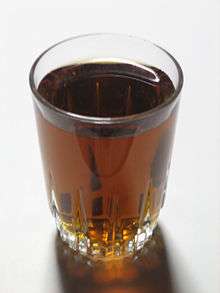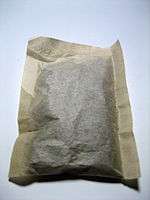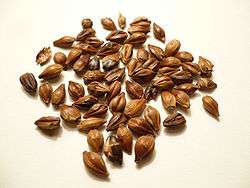Roasted barley tea



Roasted barley tea is a caffeine-free, roasted-grain-based infusion made from barley, which is popular in Chinese, Korean, and Japanese cuisine. It is also used as a caffeine-free coffee substitute in American cuisine.
Roasted barley tea is called mugicha (麦茶) in Japanese, dàmàichá (大麦茶) or màichá (麦茶 or 麥茶) in Mandarin Chinese, and boricha (보리차) in Korean. In Japan it is generally regarded as a cooling beverage, while in China and Korea it is served year-round, warm in the cold winter and cool in the hotsummer. Originally, roasted barley seeds were stewed in warm water (this is still the method generally used in Korea), but tea bags containing ground barley became more popular during the early 1980s; this is now the norm in Japan. It can be found from many different distributors in vending machines all over Japan.
In Korea, roasted unhulled barley is used to prepare the tea. Often the barley is combined with oksusu cha (roasted corn), as the corn's sweetness offsets the slightly bitter flavor of the barley. A similar drink, made from roasted brown rice, is called hyeonmi cha.
Roasted barley tea, sold in ground form and sometimes combined with chicory or other ingredients, is also sold as a coffee substitute.[1]
Health effects
Roasted barley tea was found to inhibit bacterial colonization and adhesion, specifically with respect to the major cause of tooth decay also implicated in cardiovascular diseases, Streptococcus mutans biofilms.[2] It also lowers blood viscosity, proportional to the level of alkylpyrazine in the tea.[3] The roasting process revealed 200 - 600 micrograms/kg of acrylamide among Japanese mugicha.[4] The same article notes that this is far less than the amount found in potato crisps and other whole potato snack foods which had levels >1000 μg / kg. Only a few grams of roasted barley are used to make a cup of tea. The article does not propose that the full amount of acrylamide found in the dry roasted barley is ingested when the grains are soaked in hot water and then discarded. Acrylamide and its metabolite, glycidamide, react readily with a number of biomolecules including haemoglobin.[5]
See also
References
- ↑ Maier, H. G. (1987). "Coffee Substitutes Made from Cereals". In Clarke, R.J.; Macrae, R. Coffee: Related Beverages. pp. 5–8. ISBN 978-1-85166-103-9.
- ↑ Stauder, Monica; Papetti, Adele; Daglia, Maria; Vezzulli, Luigi; Gazzani, Gabriella; Varaldo, Pietro E.; Pruzzo, Carla (2010). "Inhibitory Activity by Barley Coffee Components Towards Streptococcus Mutans Biofilm". Current Microbiology. 61 (5): 417. doi:10.1007/s00284-010-9630-5. PMID 20361189.
- ↑ Suganuma, Hiroyuki; Inakuma, Takahiro; Kikuchi, Yuji (2002). "Amelioratory Effect of Barley Tea Drinking on Blood Fluidity". Journal of Nutritional Science and Vitaminology. 48 (2): 165. doi:10.3177/jnsv.48.165. PMID 12171439.
- ↑ Ono, H.; Chuda, Y.; Ohnishi-Kameyama, M.; Yada, H.; Ishizaka, M.; Kobayashi, H.; Yoshida, M. (2003). "Analysis of acrylamide by LC-MS/MS and GC-MS in processed Japanese foods". Food Additives and Contaminants. 20 (3): 215. doi:10.1080/0265203021000060887. PMID 12623644.
- ↑ Health Implications of Acrylamide in Food. World Health Organization. 2002. ISBN 92-4-156218-8.

